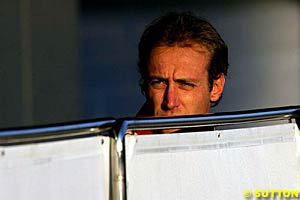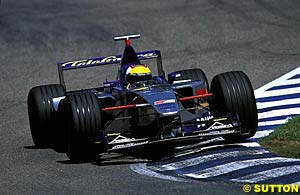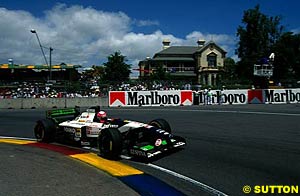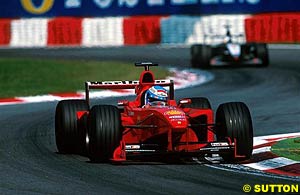
Atlas F1 Senior Writer
Luca Badoer has probably covered more miles than any other driver in recent years, yet the 33-year old Italian continues to live in the shadow of Ferrari's racing drivers. Yet he is still a key element in Ferrari's run of unprecedented success. Thomas O'Keefe looks back at Badoer's career and proposes Ferrari a way to thank the Italian for his hard work
What was Luca Badoer like when he was a race driver? It was a different place and time from the Formula One world Badoer now inhabits. Ferrari had not yet stamped their dominance on the sport, although they were on the verge of doing so. As of the September 26, 1999 European Grand Prix at the Nurburgring with three races left in the season, there were four - count 'em, four - Drivers' Championship contenders within 10 points of one another: Mika Hakkinen (McLaren-Mercedes), Eddie Irvine (Ferrari, having moved up to team leader after Schumacher's accident at Silverstone), Heinz-Harald Frentzen and David Coulthard (McLaren-Mercedes).
Heinz-Harald Frentzen was driving a Jordan, powered by Mugen-Honda, in which he had won both the French and Italian Grands Prix in the 1999 season. Indeed, Jordan were ranked third in the 1999 constructors' standings and, hard as this is to imagine today, Frentzen was on pole at the Nurburgring ahead of the McLarens.
Johnny Herbert qualified his Stewart-Ford in 14th place, just ahead of his teammate Rubens Barrichello. It was known at that time that Stewart-Ford would be transformed into the newly-formed Jaguar Racing team for the 2000 season. Stewart were running their last three races as a marque and had not yet had a win.
In the driver's musical chairs of the time, it was rumored that Barrichello would be replacing Irvine at Ferrari; Hakkinen had been rumored to join Jaguar of all things, but had renewed at McLaren. The Inaugural US Grand Prix was being discussed and anticipated but would not happen for another year.
It was the year BAR were schizophrenic in their livery, half Lucky Strike, half 555 colors, that Mika Hakkinen was brought to tears at Monza, that Alex Zanardi was in the Winfield Williams as teammate to Ralf Schumacher, and that Ralf's brother Michael was home in Switzerland nursing a bum leg from the day when the brakes gave up at Stowe corner.
Sprinkled through the field that chilly day at the Nurburgring were several drivers who are now the backbone of the current testing cadre in Formula One: "too-tall" Alexander Wurz was then driving for Benetton-Playlife (one red boot, one blue), Ricardo Zonta was with BAR and Olivier Panis was with Prost-Peugeot. Marc Gene was in a Minardi as was his teammate, Luca Badoer. Pedro de la Rosa was in an Arrows. Today, Wurz and de la Rosa test for McLaren, Zonta and Panis for Toyota and Marc Gene tests for Ferrari.
In those days, Minardi did not always occupy the last row of the grid and in the 1999 European Grand Prix, the two Arrows team cars had that distinction. Badoer qualified 19th ahead of his teammate Gene.
It was a classic wet/dry weekend in the Eifel Mountains that threw up the kind of iffy weather conditions that create attrition and thus opportunities for the backmarkers. Minardi drivers Gene and Badoer made the most of their chances, as one by one the frontrunners went by the boards.
The openings came thick and fast, with the first one on lap 1, turn 1, where a chain reaction accident put Wurz and Pedro Diniz out, as Badoer headed for the safety of the grass to avoid the incident. By lap six, Badoer had moved up to 17th. On lap 11, Zanardi had an incident on the Coca Cola curve with the Arrows of de la Rosa, which Badoer narrowly missed, moving him up another spot to 16th place.
On lap 18, the umbrellas started to appear in the grandstands and the onset of rain seemed to inspire local boy Ralf Schumacher, who had a fierce, recurring overtaking battle with Coulthard's McLaren from the Coca Cola curve down to the Mercedes Grandstand at turn 1, in which Schumacher was the ultimate winner. The deteriorating weather conditions tended to equalize the power differential between Coulthard's Mercedes and Schumacher's Supertec engine. But all credit to Ralf who, on dry Bridgestone Potenzas, showed real talent and courage throughout that day, pulling up to second place as the rains intensified and yet he seemed oblivious to it all.
Meanwhile, back in the pits, Badoer's future team, Ferrari, were making a mess of things with the Second String drivers, including a 37.9 second pitstop for substitute driver Mika Salo and a cocked-up pitstop for Irvine, where his car sat idly with only three tyres on it while the now-legendary Ferrari pit crew scrambled around for 28.2 seconds looking for Irvine's right rear. It is from such humiliating moments as those nearly simultaneously disastrous Ferrari pitstops in September 1999 that Ferrari's current superiority has been forged. The indecision and lack of communication manifest in those pitstops would be unthinkable today at Ferrari.
By lap 21, the track was wet in some areas and still dry in others as the storm clouds loomed overhead and drivers and team managers were making their bets in the dicey but fast-changing conditions.
While the Italian team from Maranello were embarrassing themselves, the other Italian team, from Faenza, were having one of the most promising days in their history. The Telefonica and Fondmetal-sponsored Minardis of Gene and Badoer steadily moved up the order, not having been suckered into making a pitstop for wet tyres during the first rains. With 30 laps remaining in the 66-lap race, Gene was up to ninth and Badoer right behind him in 10th, both of them ahead of Hakkinen, who had made some improvident pitstops. Just after lapping Badoer, Coulthard, who was leading the race, skidded off the track when caught out on dry tyres as the second rains came.
Throughout the race the Minardis had moved up, as first Frentzen and then Coulthard retired while leading, and were now solidly poised for a strong finish and threatening to actually score points (which in that era were awarded only for the top six positions). Minardi's highest finish, then or now, was a fourth place (Pierluigi Martini's Minardi-Ferrari in 1991 and Christian Fittipaldi in 1993), so this was beginning to shape up as an historic moment for the team.
With 21 laps left, Badoer, driving a cautious but heady race, had gotten by teammate Gene and was up to an incredible seventh place, with the Ferrari of Eddie Irvine behind him in eighth place and Gene tailing Irvine in ninth. A Ferrari in a Minardi sandwich: you just knew this was going to be a singular kind of day in Grand Prix Racing.
With 19 laps left, Badoer finally clawed his way into sixth place and a points-paying position, still staying ahead of Irvine's Ferrari, who was then in the running for the Championship. Up front, the race had its fourth leader, as Giancarlo Fisichella's Benetton led Johnny Herbert's Stewart until Fisichella too slithered off at the Veedol Chicane in the wet, soon followed by successor leader Ralf Schumacher, who took the lead and then promptly had a severe blowout in his right rear tyre, promoting Herbert to first place and Badoer to fourth place as the race entered its final phase.
No, it was not to be, even on this strangest of strange days at the Nurburgring. Luck was not on Luca's side and in a heartbreaking scene, Badoer pulled his Minardi MO1 Ford Zetec off the course on the approach to the Veedol chicane, the Minardi unable to go any further due to a smoky seizure of the gearbox with an unlucky 13 laps left to go. Do you think this cruel turnabout got to the hard-bitten race driver who had suffered a slew of insults over the years and thought that he was finally headed for his first podium? You bet it did.
After flinging the steering wheel out of the Minardi in exasperation, Badoer got to his feet briefly to retrieve the steering wheel and replace it on the steering column, dutiful driver that he was, only to fall back to his knees, emotionally spent, his helmeted head buried in his arms as he wept from the depths of his soul on the carbon-fibre Minardi cockpit, the tears hidden by the visor but the body language telling us that Luca Badoer had hit rock bottom.
Jackie Stewart and Paul Stewart had their happiest day (and, as it would turn out, the only victory for the genetically-connected Stewart and Jaguar teams), Herbert surviving the melee to finish first, with his teammate Barrichello on the podium in third place. Marc Gene did hold onto sixth place for Minardi and the 1999 European Grand Prix passed into history as one of the oddest and most fascinating of Grands Prix, where virtually every driver figured in the events of the race in an interesting way, and had a chance to demonstrate their talents, not the least of them the crestfallen Luca Badoer.
Badoer finished out the last two races of the 1999 season with Minardi and has never driven in race conditions since that time. The irony is that the 1999 season where he was doing double duty – being allowed by Ferrari to race for Minardi while testing for them – was probably his best possible chance to become a full-time Ferrari driver had Badoer not been a race driver for Minardi.
But when Michael Schumacher had his accident at Silverstone on July 11, 1999, Ferrari (which had already decided to replace titular No. 1 driver Irvine in 2000 with Barrichello), after first offering the Schumacher seat to ex-Ferrari man Jean Alesi (who declined), chose not to promote Badoer in-house and instead went with outsider Mika Salo as Michael Schumacher's stand-in, depriving Badoer of his Big Chance.
Badoer says he asked the team why he was not chosen and "they said it would be too much pressure on me [because I am Italian] and everyone else in the team. I do not agree with this. I know myself. I have a very strong character and mind. I know I could have coped with the pressure. However, this is something that only I know."
Interestingly, Alesi backed Badoer, telling RAI TV: "Ferrari's decisions are none of my business, but in my opinion there is no contest between Badoer and Salo. For me, Badoer wins hands down."
So, by the time of the Nurburgring in September 1999, it is no wonder that Luca Badoer was emotionally drained that day as he collapsed on the cockpit of the Minardi: it had been a momentous year for him.
Having descended into the depths at Nurburgring in 1999, Luca Badoer's luck began to change and he went from strength to strength at Maranello, becoming the most valued Ferrari test driver by Ross Brawn and the principal race drivers and gradually moving up the radar as far as he wanted to within the Ferrari superstructure: being more visible on the race weekends in the paddock with Ferrari's sponsors and the media and being featured in all the extra-curricular events that Ferrari engages in over the course of the year, including demonstration runs at Vallelunga and Zandvoort, ice-kart racing wheel to wheel with Michael and participating along with the World Champion and Rubens Barrichello in those evocative, crowd-pleasing celebration sessions Ferrari has scheduled in recent years at Mugello, where a three or four-car Ferrari team appears, Luca Badoer for the only time publicly sharing the stage with his teammates.
And there were those post-9/11 races where Badoer was ready to step in for Michael Schumacher if a substitute driver was necessary since Michael seemed deeply affected by these events before the races at Monza and Indianapolis, 2001. And then when the mother of Michael and Ralf Schumacher died suddenly on the weekend of the 2003 Grand Prix of San Marino, there was another possibility of replacing Michael, but that never happened because both Schumachers decided to race at Imola.
Ferrari have been involved in some elaborate gifts over the years. Jean Alesi still has one of his race cars, a Ferrari 412 T2, which he uses to inspire himself while working out in his gym at home in Avignon to prepare himself for those DTM races. Gerhard Berger was allowed to keep the Ferrari F1/87-88C 1.5 litre V6 turbo he used to win at Monza in 1988.
On January 25, 2005, Luca Badoer will turn 34 years old. Could there be a better birthday present than for the team to announce that after countless kilometers pounding around Fiorano, Badoer will race at least once during the season come what may, at the special request of Michael Schumacher, whose brilliant career has been built on the broad shoulders of Luca Badoer. Rubens too owes Badoer for his hard work, the perversity there being that in European F3000 in 1992, Badoer took the title by 19 points over third-place finisher Barrichello, after which their careers, shall we say, sharply diverged.
A fairy tale perhaps that Ferrari should do justice to Badoer, but one way or the other, I bet that it happens, and the first Italian driver since Nicola Larini (who was Badoer's predecessor test driver at Ferrari from 1992-97) will drive for Ferrari, a fitting capstone to a fine Formula One career for the Phantom of Fiorano.
Ferrari's Michael Schumacher leads most Formula One drivers in most categories of performance but his teammate Luca Badoer has bested him thoroughly in one area: Badoer, Ferrari's principal test driver, has driven a total of over 87,000 kilometers in testing (53,940 miles or 18 times across the U.S.A. for we Yanks), and leads all 128 drivers who have tested in Formula One in the modern era, including Michael Schumacher, who places third with 67,000 kilometers.
 In addition to being the World Test Drivers' Champion, putting in over 100 days per year some years, Badoer also has a record he would very much like to be rid of: the driver who has competed in the most Grands Prix, 68 races, without scoring even one World Championship point. Thus, Luca Badoer lives in a world of extremes: he drives the best car of all – the Ferrari Formula One car – but he is not able to show the world that his driving skills are the equal of the car because he is the curious species known as the "third driver," forever ready to go "on," while waiting in the shadows.
In addition to being the World Test Drivers' Champion, putting in over 100 days per year some years, Badoer also has a record he would very much like to be rid of: the driver who has competed in the most Grands Prix, 68 races, without scoring even one World Championship point. Thus, Luca Badoer lives in a world of extremes: he drives the best car of all – the Ferrari Formula One car – but he is not able to show the world that his driving skills are the equal of the car because he is the curious species known as the "third driver," forever ready to go "on," while waiting in the shadows.
 But it was Luca Badoer who hit the jackpot as amongst the test driver set, when he was asked to test for Ferrari on a permanent basis, while being permitted to be a race driver for Minardi during 1999, which was in a rebuilding mode, with a fresh injection of capital from shareholder Gabriele Rumi, all of this pre-Paul Stoddart.
But it was Luca Badoer who hit the jackpot as amongst the test driver set, when he was asked to test for Ferrari on a permanent basis, while being permitted to be a race driver for Minardi during 1999, which was in a rebuilding mode, with a fresh injection of capital from shareholder Gabriele Rumi, all of this pre-Paul Stoddart.
 Would the hapless Minardi team, which had not been in the points since Pedro Lamy had scored a sixth place in the 1995 Australian Grand Prix, and their heretofore luckless but determined 28 year-old Italian driver who had never in his career finished higher than seventh place, finally get a podium or at least the recognition that Luca Badoer's gritty drive in horrible conditions deserved?
Would the hapless Minardi team, which had not been in the points since Pedro Lamy had scored a sixth place in the 1995 Australian Grand Prix, and their heretofore luckless but determined 28 year-old Italian driver who had never in his career finished higher than seventh place, finally get a podium or at least the recognition that Luca Badoer's gritty drive in horrible conditions deserved?
 Badoer was gutted at being snubbed, first by Ferrari offering the job to Alesi, and then doubly so by the offer to Salo, but within two days of Schumacher's accident, the deal was done and Salo was testing at Monza on July 13, 1999. To his credit, Luca Badoer did not suffer in silence and spoke out on being passed over: "I'm very disappointed with that decision," said Badoer. "I do not agree with it because I think I was the right person. I'm under contract for that job, I am their test driver."
Badoer was gutted at being snubbed, first by Ferrari offering the job to Alesi, and then doubly so by the offer to Salo, but within two days of Schumacher's accident, the deal was done and Salo was testing at Monza on July 13, 1999. To his credit, Luca Badoer did not suffer in silence and spoke out on being passed over: "I'm very disappointed with that decision," said Badoer. "I do not agree with it because I think I was the right person. I'm under contract for that job, I am their test driver."
 Will it ever be thus or will the Other Luca, Luca di Montezemolo, Ross Brawn and Jean Todt (known to be a soft touch beneath the forbidding Gallic facade), finally find a way to give the 33 year-old Luca Badoer a second chance at the opportunity that passed him by in 1999 to drive in a race for Ferrari. With seven-time World Champion Michael Schumacher's legend secure and the Ferrari mystique firmly in place for generations to come, entrusting a Ferrari to Badoer in race conditions is a risk that the team can afford to take. It would be fitting that Badoer should end his career driving a Ferrari since his career began driving a Lola-Ferrari in 1993 for the Chesterfield-sponsored Scuderia Italia.
Will it ever be thus or will the Other Luca, Luca di Montezemolo, Ross Brawn and Jean Todt (known to be a soft touch beneath the forbidding Gallic facade), finally find a way to give the 33 year-old Luca Badoer a second chance at the opportunity that passed him by in 1999 to drive in a race for Ferrari. With seven-time World Champion Michael Schumacher's legend secure and the Ferrari mystique firmly in place for generations to come, entrusting a Ferrari to Badoer in race conditions is a risk that the team can afford to take. It would be fitting that Badoer should end his career driving a Ferrari since his career began driving a Lola-Ferrari in 1993 for the Chesterfield-sponsored Scuderia Italia.
|
Contact the Author Contact the Editor |
Please Contact Us for permission to republish this or any other material from Atlas F1.
|
Volume 10, Issue 51
The Season of the Struggle
The Phantom of Fiorano
Tech Talk with Sauber's Willi Rampf
2004 Testing SuperStats
Bookworm Critique
On the Road
Elsewhere in Racing
The Weekly Grapevine
> Homepage |